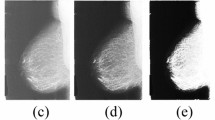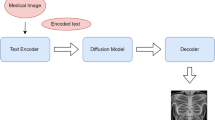Abstract
The quality of medical images is critical for accurate diagnosis. This paper introduces a novel Quantum-behaved Arithmetic Optimization Algorithm (QAOA) for medical images. A mutation operator with Gaussian probability distribution is used in the proposed QAOA as a powerful strategy to enhance QAOA performance in preventing premature convergence to local optima. Gaussian QAOA (GQAOA) is tailored for medical image enhancement and hybridized with Contrast Limited Adaptive Histogram Equalization (CLAHE) to boost the information contents and details of medical images. GQAOA computes the optimal clip limit and other parameters of CLAHE using a new multi-objective fitness function. A combination of five image quality measurements including contrast, information entropy, edge information, Structural Similarity Index Measure (SSIM), and sharpness is suggested as an efficient fitness function to help the proposed framework produce good results. A comparative study is conducted with well-known histogram-based process techniques and state-of-art methods to demonstrate the efficiency of the suggested algorithm. The experimental results prove that the suggested approach performs better than the most current well-established enhancement strategies in the terms of visual interpretation, information entropy, SSIM, Peak Signal to Noise Ratio (PSNR), Naturalness Image Quality Evaluator (NIQE), Absolute Mean Brightness Error (AMBE), and Quality Index (QI) metrics.












Similar content being viewed by others
Data availability
The datasets generated during and/or analyzed during the current study are available at https://medpix.nlm.nih.gov
References
Abualigah L, Diabat A, Mirjalili S, Abd Elaziz M, Gandomi AH (2021) The arithmetic optimization algorithm. Comput Methods Appl Mech Eng 376:113609. https://doi.org/10.1016/J.CMA.2020.113609
Abualigah L, Diabat A, Sumari P, Gandomi AH (2021) A novel evolutionary arithmetic optimization algorithm for multilevel thresholding segmentation of COVID-19 CT images. Processes 9:1155. https://doi.org/10.3390/PR9071155
Acharya UK, Kumar S (2020) Particle swarm optimized texture based histogram equalization (PSOTHE) for MRI brain image enhancement. Optik (Stuttg) 224:165760. https://doi.org/10.1016/J.IJLEO.2020.165760
Acharya UK, Kumar S (2021) Genetic algorithm based adaptive histogram equalization (GAAHE) technique for medical image enhancement. Optik (Stuttg) 230:166273. https://doi.org/10.1016/J.IJLEO.2021.166273
Agushaka JO, Ezugwu AE (2021) Advanced arithmetic optimization algorithm for solving mechanical engineering design problems. PLoS One 16(8):e0255703. https://doi.org/10.1371/JOURNAL.PONE.0255703
Bhandari AK, Kandhway P, Maurya S (2020) Salp swarm algorithm based optimally weighted histogram framework for image enhancement. IEEE trans Instrum Meas 1–1. https://doi.org/10.1109/tim.2020.2976279
Birdal T (2022) Sharpness Estimation From Image Gradients - File Exchange - MATLAB Central. https://www.mathworks.com/matlabcentral/fileexchange/32397-sharpness-estimation-from-image-gradients. Accessed 25 Feb 2022
Campos GFC, Mastelini SM, Aguiar GJ, Mantovani RG, Melo LF, Barbon, Sylvio, Jr (2019) Machine learning hyperparameter selection for contrast limited adaptive histogram equalization. Eurasip J Image Vid Process 2019:1–18. https://doi.org/10.1186/s13640-019-0445-4
Chandrashekar L, Sreedevi A (2020) A multi-objective enhancement technique for poor contrast magnetic resonance images of brain glioblastomas. Procedia Comput Sci 171:1770–1779. https://doi.org/10.1016/J.PROCS.2020.04.190
Cunha Carneiro P, Lemos Debs C, Oliveira Andrade A, Patrocinio AC (2019) CLAHE parameters effects on the quantitative and visual assessment of dense breast mammograms. IEEE Lat Am Trans 17:851–857. https://doi.org/10.1109/TLA.2019.8891954
da Rocha DA, Barbosa ABL, Guimarães DS et al (2020) An unsupervised approach to improve contrast and segmentation of blood vessels in retinal images using CLAHE, 2D Gabor wavelet, and morphological operations. Res Biomed Eng 361 36:67–75. https://doi.org/10.1007/S42600-019-00032-Z
Dabass J, Vig R (2018) Biomedical image enhancement using different techniques - a comparative study. In: International conference on recent developments in science, Engineering and Technology. Springer Verlag, pp. 260–286
Der Chen S, Ramli AR (2003) Minimum mean brightness error bi-histogram equalization in contrast enhancement. IEEE Trans Consum Electron 49:1310–1319. https://doi.org/10.1109/TCE.2003.1261234
Dhal KG, Das S (2018) Colour retinal images enhancement using modified histogram equalisation methods and firefly algorithm. Int J Biomed Eng Technol 28:160–184. https://doi.org/10.1504/IJBET.2018.094725
Dhal KG, Sen M, Das S (2018) Cuckoo search-based modified bi-histogram equalisation method to enhance the cancerous tissues in mammography images. Int J Med Eng Inform 10:164–187. https://doi.org/10.1504/IJMEI.2018.091209
Gautam R, Samuel A, Sil S et al (2015) Raman and mid-infrared spectroscopic imaging: applications and advancements. Curr Sci 108:341–356. https://doi.org/10.2307/24216561
Huang X, Li C, Pu Y, He B (2019) Gaussian quantum bat algorithm with direction of mean best position for numerical function optimization. Comput Intell Neurosci 2019:1–18. https://doi.org/10.1155/2019/5652340
Ibrahim RA, Abualigah L, Ewees AA, al-qaness MAA, Yousri D, Alshathri S, Abd Elaziz M (2021) An electric fish-based arithmetic optimization algorithm for feature selection. Entropy 23:1189. https://doi.org/10.3390/E23091189
Joseph J, Periyasamy R (2018) A fully customized enhancement scheme for controlling brightness error and contrast in magnetic resonance images. Biomed Signal Process Control 39:271–283. https://doi.org/10.1016/j.bspc.2017.08.003
Joseph J, Sivaraman J, Periyasamy R, Simi VR (2017) An objective method to identify optimum clip-limit and histogram specification of contrast limited adaptive histogram equalization for MR images. Biocybern Biomed Eng 37:489–497. https://doi.org/10.1016/J.BBE.2016.11.006
Kandhway P, Bhandari AK, Singh A (2020) A novel reformed histogram equalization based medical image contrast enhancement using krill herd optimization. Biomed Signal Process Control 56:101677. https://doi.org/10.1016/j.bspc.2019.101677
Kaveh A, Biabani Hamedani K (2022) Improved arithmetic optimization algorithm and its application to discrete structural optimization. Structures 35:748–764. https://doi.org/10.1016/J.ISTRUC.2021.11.012
Khatir S, Tiachacht S, Le Thanh C et al (2021) An improved artificial neural network using arithmetic optimization algorithm for damage assessment in FGM composite plates. Compos Struct 273:114287. https://doi.org/10.1016/J.COMPSTRUCT.2021.114287
Kim YT (1997) Contrast enhancement using brightness preserving bi-histogram equalization. IEEE Trans Consum Electron 43:1–8. https://doi.org/10.1109/30.580378
Kumar N, Shaikh AA, Mahato SK, Bhunia AK (2021) Applications of new hybrid algorithm based on advanced cuckoo search and adaptive Gaussian quantum behaved particle swarm optimization in solving ordinary differential equations. Expert Syst Appl 172:114646. https://doi.org/10.1016/J.ESWA.2021.114646
Kuran U, Kuran EC (2021) Parameter selection for CLAHE using multi-objective cuckoo search algorithm for image contrast enhancement. Intell Syst with Appl 12:200051. https://doi.org/10.1016/J.ISWA.2021.200051
More LG, Brizuela MA, Ayala HL et al (2015) Parameter tuning of CLAHE based on multi-objective optimization to achieve different contrast levels in medical images. In: IEEE international conference on image processing (ICIP). IEEE, Quebec City, pp 4644–4648. https://doi.org/10.1109/ICIP.2015.7351687
Olivia Popnoe D, Ng CS, Zhou S, Cheenu Kappadath S, Pan T, Kyle Jones A (2019) Comparison of enhancement quantification from virtual unenhanced images to true unenhanced images in multiphase renal dual-energy computed tomography: a phantom study. J Appl Clin Med Phys 20:171–179. https://doi.org/10.1002/acm2.12685
Pashaei E (2021) Medical image enhancement using guided filtering and chaotic inertia weight black hole algorithm. In: 5th international symposium on multidisciplinary studies and innovative technologies (ISMSIT). IEEE, pp 37–42
Pashaei E, Pashaei E (2022) A fusion approach based on black hole algorithm and particle swarm optimization for image enhancement. Multimed Tools Appl 2022:1–29. https://doi.org/10.1007/S11042-022-13275-3
Pashaei E, Pashaei E (2022) Hybrid binary arithmetic optimization algorithm with simulated annealing for feature selection in high-dimensional biomedical data. J Supercomput 2022:1–40. https://doi.org/10.1007/S11227-022-04507-2
Pashaei E, Pashaei E, Aydin N (2020) Hybrid krill herd algorithm with particle swarm optimization for image enhancement. In: Kahraman C, Cevik Onar S, Oztaysi B et al (eds) International conference on intelligent and fuzzy systems (INFUS 2020). Springer, Cham, Istanbul, 1197:1431–1439
Patel S, Bharath KP, Balaji S, Muthu RK (2020) Comparative study on histogram equalization techniques for medical image enhancement. Springer, Singapore
Seok Min B, Kyun Lim D, Jong Kim S, Heung Lee J (2013) A novel method of determining parameters of CLAHE based on image entropy. Int J Softw Eng its Appl 7:113–120. https://doi.org/10.14257/ijseia.2013.7.5.11
Singh K, Kapoor R, Sinha SK (2015) Enhancement of low exposure images via recursive histogram equalization algorithms. Optik (Stuttg) 126:2619–2625. https://doi.org/10.1016/J.IJLEO.2015.06.060
Singh K, Vishwakarma DK, Walia GS, Kapoor R (2016) Contrast enhancement via texture region based histogram equalization. J Mod Opt 63:1444–1450. https://doi.org/10.1080/09500340.2016.1154194
Singh M, Verma A, Sharma N (2017) Bat optimization based neuron model of stochastic resonance for the enhancement of MR images. Biocybern Biomed Eng 37:124–134. https://doi.org/10.1016/j.bbe.2016.10.006
Siracusano G, La Corte A, Gaeta M et al (2020) Pipeline for advanced contrast enhancement (PACE) of chest X-ray in evaluating COVID-19 patients by combining Bidimensional empirical mode decomposition and contrast limited adaptive histogram equalization (CLAHE). Sustainability 12:1–17. https://doi.org/10.3390/SU12208573
Sonali SS, Singh AK et al (2019) An approach for de-noising and contrast enhancement of retinal fundus image using CLAHE. Opt Laser Technol 110:87–98. https://doi.org/10.1016/J.OPTLASTEC.2018.06.061
Waite S, Grigorian A, Alexander RG, Macknik SL, Carrasco M, Heeger DJ, Martinez-Conde S (2019) Analysis of perceptual expertise in radiology – current knowledge and a new perspective. Front Hum Neurosci 13. https://doi.org/10.3389/fnhum.2019.00213
Wang Y, Chen Q, Zhang B (1999) Image enhancement based on equal area dualistic sub-image histogram equalization method. IEEE Trans Consum Electron 45:68–75. https://doi.org/10.1109/30.754419
Yuan L, Kuang F, Zhang S, Chen H (2022) The Gaussian mutational Barebone dragonfly algorithm: from design to analysis. Symmetry 14:331 14–331 331331. https://doi.org/10.3390/SYM14020331
Zhou Y, Shi C, Lai B, Jimenez G (2019) Contrast enhancement of medical images using a new version of the world cup optimization algorithm. Quant Imaging Med Surg 9:1528–1547. https://doi.org/10.21037/qims.2019.08.19
Author information
Authors and Affiliations
Corresponding author
Ethics declarations
Conflict of interests
The authors declare that they have no conflict of interest.
Additional information
Publisher’s note
Springer Nature remains neutral with regard to jurisdictional claims in published maps and institutional affiliations.
Rights and permissions
Springer Nature or its licensor (e.g. a society or other partner) holds exclusive rights to this article under a publishing agreement with the author(s) or other rightsholder(s); author self-archiving of the accepted manuscript version of this article is solely governed by the terms of such publishing agreement and applicable law.
About this article
Cite this article
Pashaei, E., Pashaei, E. Gaussian quantum arithmetic optimization-based histogram equalization for medical image enhancement. Multimed Tools Appl 82, 34725–34748 (2023). https://doi.org/10.1007/s11042-023-15025-5
Received:
Revised:
Accepted:
Published:
Issue Date:
DOI: https://doi.org/10.1007/s11042-023-15025-5




